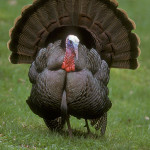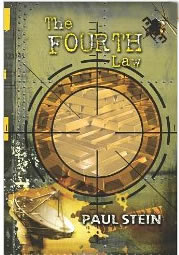Not So Dumb
By Paul Stein
 Here’s the idyllic Thanksgiving story we’ve all come to believe:
Here’s the idyllic Thanksgiving story we’ve all come to believe:
In 1621, the original American Colonists held a feast in Plymouth to celebrate their first harvest. These Pilgrims were dressed in black and white with buckles on their shoes. They invited Wampanoag Indians, and everyone gobbled down turkey and pumpkin pie.
Makes a nice story but almost certainly not true.
Historians, including those at Plymouth Plantation, in Massachusetts, say that there was indeed a feast in 1621 shared by the Colonists and Indians. But in all likelihood deer was served, and although pumpkin was available it’s improbable the Colonists whipped up a pie. Sweet potatoes were unknown and cranberries were undoubtedly not served as a relish. The Pilgrims incidentally, did not dress everyday in black and white and didn’t wear buckles on their shoes.
Who made up this fanciful tale? Probably Sarah Josepha Hale, a popular editor of Godey’s Lady’s Magazine who read about the 1621 feast and decided to model it as an annual holiday. (Hale authored the nursery rhyme: ‘Mary had a little lamb’). She published recipes for turkey and stuffing and pumpkin pie and started traditions that had nothing to do with the Colonists.
Thanksgiving became an official holiday in the United States on October 3, 1863 via a proclamation by President Abraham Lincoln. This was largely due to the tireless lobbying efforts of Hale, who had lobbied five former presidents for the holiday. The proclamation declared that the last Thursday in November would be forever celebrated as Thanksgiving Day. Turkey dinner, thanks to Sarah Hale, became the centerpiece of this family celebration known as Turkey Day.
The wild turkey (Meleagris gallopa) bears little resemblance to the domestic butter ball turkey
Americans serve at Thanksgiving. It is native to North America and was a staple in the Native American diet. It was imported to Europe in the early part of the 16th century by the Spaniards via Turkey (the country.) Confused in those early times with the Guinea fowl which also arrived via Turkey, both birds were called turkeys in those days. When it was assigned its Latin name in the 18th century, the name turkey still stuck.
The range and numbers of the wild turkey had decreased at the beginning of the 20th century due to hunting and loss of habitat. Game managers estimate that the entire population of wild turkeys in the United States was as low as 30,000 in the early 20th century. Game officials made efforts to protect and encourage the breeding of the surviving wild population, and some birds were relocated to new areas, including California where it was not native.
The first record of modern wild turkey introduction into California was in 1877 when birds from Mexico were released on Santa Cruz Island by private ranchers. Records of releases by the Department of Fish and Wildlife began in 1908 when 22 turkeys from Mexico were released in the San Bernardino Mountains. Other releases in different locations continued throughout the 20th century and included the Merraim and Rio Grande subspecies. Rio Grande turkeys have become the dominant subspecies established in most of the lower elevation oak woodlands and they are locally abundant in many areas of the state including Calaveras County. Current estimates place the entire wild turkey population at 7 million individuals. The Rio Grande Turkey is gregarious.
Look up turkey in the dictionary and you’ll see the term defined as slang for a naïve, stupid or inept person; a dud or loser. The idea that turkeys characterize stupidity is deeply ingrained in the American psyche. Maybe it’s their awkward gait, the wobbly red wattles under their necks, or the strange sounds they make, but turkeys have gained a reputation for being stupid creatures.
The “dumb bird” reputation probably stems from the oft repeated tale that during rainstorms turkeys will stare at the sky transfixed with their beaks open, until they drown. Although turkeys sometimes do tilt their heads up at the sky and remain there for several moments, scientists say the idea that turkeys drown in this manner is pure myth.
So why do turkeys sometimes stare skyward? Tom Savage, a professor of animal science at Oregon State University, says that the root of this behavior is not stupidity, but genes. Savage discovered an inherited condition in turkeys, called titanic torticollar spasms. This condition can cause turkeys to exhibit abnormal behaviors, such as looking at the sky for thirty seconds or longer. “I’ve always viewed turkeys as smart animals with personality and character, and keen awareness of their surroundings,” Savage said. “The dumb tag simply doesn’t fit. I’m and advocate of turkeys,” he added, “except at Thanksgiving.”
Turkeys actually aren’t dumb as they may look. They socialize with each other, and if humans are around, they will greet them and enjoy their company.
Here are some real facts about turkeys:
- Domestic turkeys can’t fly; they lose their aerodynamic properties because of how they are bred for heavy meat production.
- Wild turkeys are agile fliers. In an ideal habitat of open woodland or wooded grasslands they may fly beneath the canopy top and find perches. They usually fly close to the ground for no more than a quarter mile.
- Turkeys are often spooked by loud noises and will crowd together for protection.
- The wild turkey was Benjamin Franklin’s pick for America’s national bird.
- Wishes come true for anyone breaking the large half of a dried wishbone from a Thanksgiving turkey.
Count your blessings and have a Happy Thanksgiving!
Paul Stein is a biologist with a long career in aquaculture. He was formerly chief deputy director of the California Department of Fish & Wildlife. He can be reached at [email protected]



